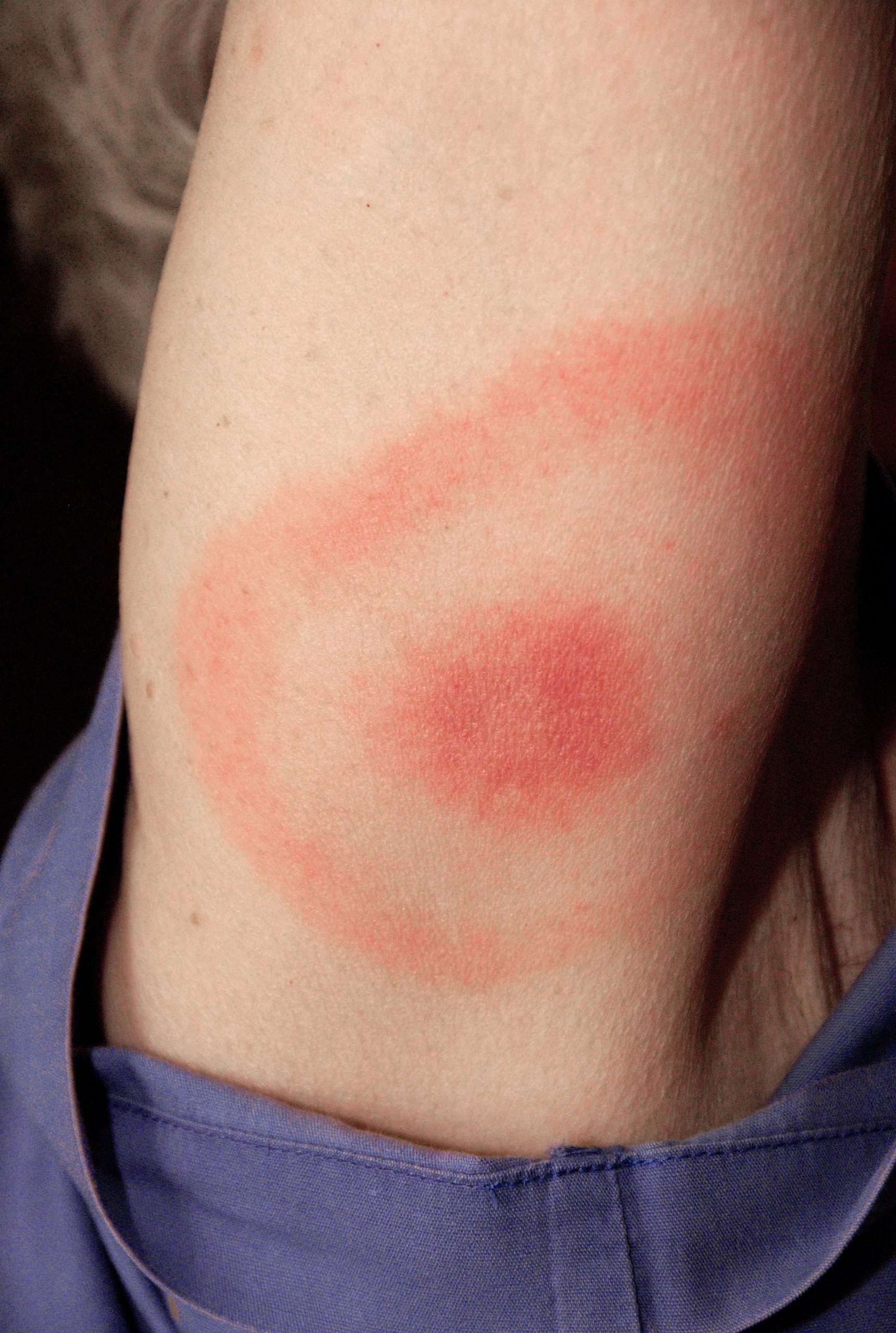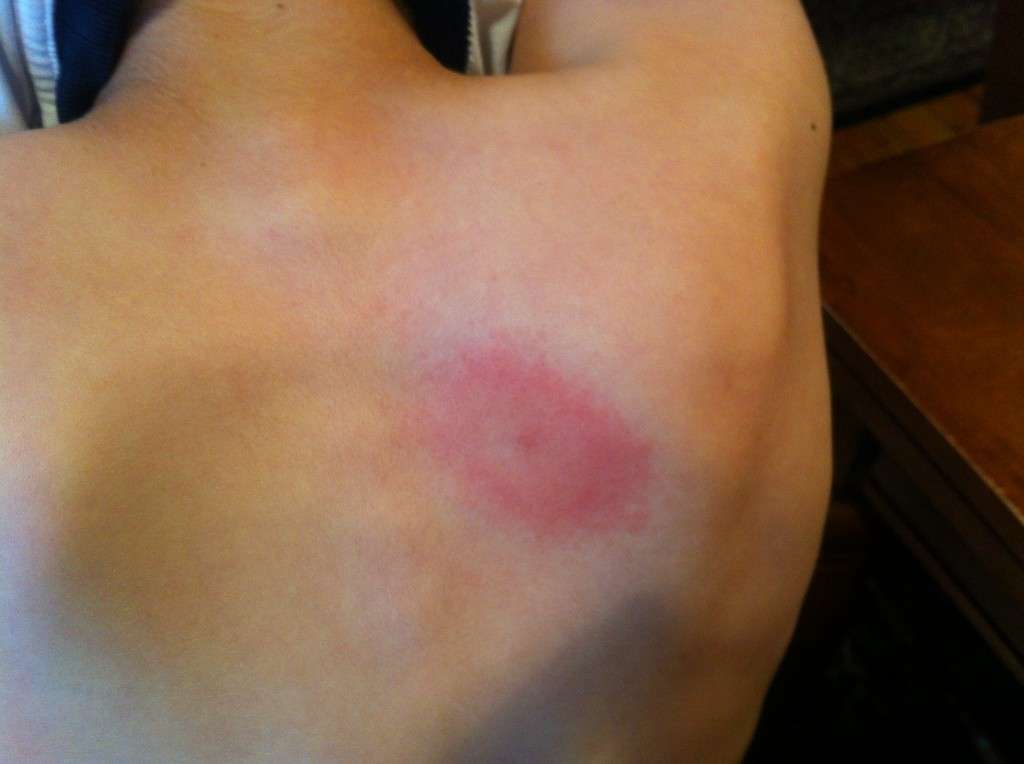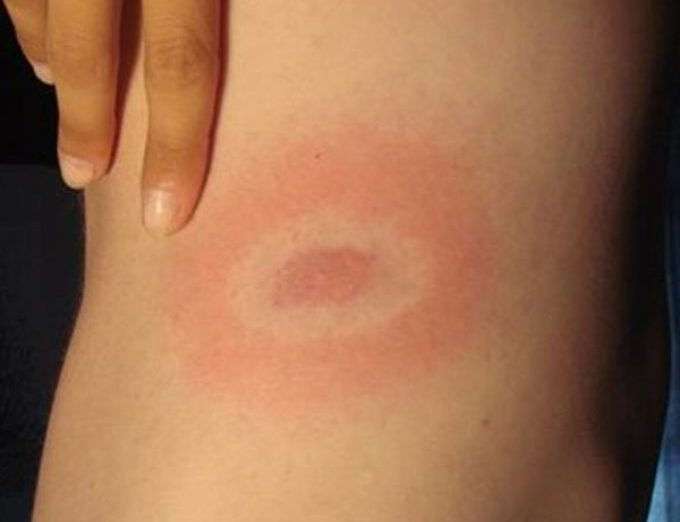Stage : Small Oval Rashes Or A Reddish Lump
When a tick that causes Lyme disease bites you, it infects you with bacteria. Without treatment, the bacteria can spread to other areas of your body. Stage 2 begins when the bacteria spread to other parts of your body.
During this stage, you may see small, oval rashes on your skin. Some people develop a bluish-red lump.
Where you see these signs: Because the infection has spread, small rashes can appear anywhere on your skin, except for your palms and soles. Most rashes appear on the arms, legs, and face.
Some people develop a lump, which your doctor may refer to as borrelial lymphocytoma. In children, this lump tends to appear on an earlobe. Adults often see a raised growth form around a nipple.
Borrelial lymphocytoma on a childs ear
This can appear in stage 2 of Lyme disease.
What you may see on your skin: The rashes that appear during stage 2 differ from the rash that can appear in stage 1. In stage 2, the rashes stay the same size rather than grow larger.
When the rashes, lump, and symptoms begin: About 30 to 45 days after the tick bites you, you may notice rashes or a lump. These can also take longer to appear, sometimes six months or more.
Some people develop symptoms, which make them feel ill, including:
-
Fever
-
Shortness of breath and dizzy spells
-
Bells palsy, which causes one half of the face to droop
-
Heart problems, such as chest pains or an irregular heartbeat
What Are The Complications Of Lyme Disease
Lyme disease affects people differently. Relapse and incomplete treatment responses happen. Relapse and incomplete treatment responses happen. Complications of untreated early-stage disease include:
-
Joint disease
-
Frequent hospitalizations to manage the disease
Some of these complications result in chronic, debilitating conditions.
Some people may develop post-Lyme disease syndrome . A condition also known as chronic Lyme disease includes PLDS, but also other syndromes. Usually, these are characterized by persistent musculoskeletal and peripheral nerve pain, fatigue, and memory impairment.
Heres How To Identify A Tick After A Tick Bite:
- After removing the tick, place it on a white piece of paper or clear tape, then take a picture of the front and back of the tick. DO NOT let it crawl away.
- Place the tick in a small plastic bag with a green leaf, damp cotton ball or moist piece of tissue. DO NOT place it in alcohol. Label the bag with your name, date, site of bite and how long the tick was attached.
- Use one of the following links to identify the tick.
- TickEncounter.org
- or you can download the TickTracker app on your smart phone.
You May Like: How Do You Get Diagnosed With Lyme Disease
Early Symptoms Of Lyme Disease
More than 30,000 cases of Lyme disease are reported to the Centers for Disease Control each year. The risk of Lyme disease is greatest in the spring and summer when the disease is commonly transmitted through tick bites.
Preventing tick bites is key to fending off an infection, but if you do get bit, look out for these early symptoms of Lyme disease:
When To Contact Your Doctor

See your doctor as soon as possible to find out if any treatment is necessary, based on the type of tick that bit you. Different parts of the country have different risks when it comes to diseases from tick bites.
If any of the following become noticeable in the weeks following a tick bite, seek consultation with a healthcare professional:
- You develop EM rashes.
- You have fever, drowsiness, aching muscles, or a headache within 6 weeks of a tick bite.
- A tick bit you in a geographical location known for severe tick-borne diseases, like the Western or Northeastern United States.
Its important to see your doctor as soon as you can after a tick bite, even if you dont have symptoms.
For example, in areas of the country where Lyme disease is common, doctors may recommend under certain conditions that you receive treatment for Lyme disease after a tick bite before symptoms start.
People who suspect they may have Rocky Mountain spotted fever should seek treatment as soon as they suspect it.
Your doctor can explain your risks, what complications to look for, and when to follow up. Your doctor will also complete a thorough history, exam, and testing to determine whether your symptoms are the result of a tick-borne disease.
- , which is also available online.
- Take a shower or bath within two hours of being outdoors.
- Check skin closely after being in tick-prone areas, especially under arms, behind ears, between legs, behind knees, and in hair.
Recommended Reading: Lyme Disease Symptoms Mayo Clinic
What Happens At Your Appointment
The GP will ask about your symptoms and consider any rash or recent tick bites you know about.
Lyme disease can be difficult to diagnose. It has similar symptoms to other conditions and there’s not always an obvious rash.
2 types of blood test are available to help confirm or rule out Lyme disease. But these tests are not always accurate in the early stages of the disease.
You may need to be retested if you still have Lyme disease symptoms after a negative result.
What Can I Expect Long Term If My Child Has Lyme Disease
If Lyme disease is caught and treated early, most children will make a full recovery. Some children with Lyme disease go on to experience what’s called a post-infectious syndrome with symptoms that may include feeling fatigue, joint aches and pains, headaches, difficulty sleeping, and problems concentrating. Since the infection itself is gone by this time, doctors generally don’t prescribe antibiotics. Each child is different, but it’s not uncommon for symptoms of post-infectious syndrome to linger for months, or even years, and they can be made worse by stress or other illness. But most children do make a full recovery.
Blacklegged, or deer, ticks are very small, so it helps to know what to look for when doing a tick check. Adults are about the size of sesame seeds and in the nymph or larva stage, they can be as tiny as a poppy seeds.
Recommended Reading: Lyme Ab Screen Or 0.90 Index
Other Symptoms Of Lyme Disease In Dogs
Dogs are more resilient against Lyme disease than other animals. According to an experimental study, only a few percentage of pet dogs that test positive for this disease develop symptoms.
Dog Lyme disease can also result in intermittent arthritis, similar to humans, and rarely results in a kidney infection. Other symptoms include:
- Pain in Joints and leg
- Signs of rash in areas such as the leg or the limb
- Signs of fever and illness
- Joint pain or
All of these symptoms are indicative of a tick bite.
What Does A Lyme Disease Rash Really Look Like These Pictures Explain It
You know the classic bulls-eye rashbut Lyme causes other types, like these.
A telling sign of Lyme disease is a red, circular or oval rash that expands over time like a bulls-eye. Doctors call it erythema migrans. But if youre looking for a bulls-eye pattern and ignoring other types of skin rashes and lesions, youre probably missing an important clue to your diagnosis. Surprise, surprise: relatively few Lyme rashes mimic the concentric circles of a dart board.
The classic target pattern represents just 20% of Lyme-related skin lesions in North America, notes John Aucott, MD, associate professor of medicine at Johns Hopkins University School of Medicine in Baltimore and director of the Johns Hopkins Lyme Disease Research Center.
Eighty percent dont look like that, and they constantly get misdiagnosed as spider or bug bites, he tells Health.
RELATED: 14 Lyme Disease Symptoms to Watch For
The fact is that Lyme disease rash can present itself in different ways, according to the Bay Area Lyme Foundation. How it appears on your body may depend, in part, on how long youve had it and where it shows up on your body.
Generally, erythema migrans is circular, because it spreads centrifugally from the point of the tick bite, says Dr. Aucott. But it can be more oval or elongated in shape if, for instance, the tick took its blood meal in the groove of your groin.
Also Check: Deer Ticks Carry Lyme Disease
You May Like: What Does The Rash Of Lyme Disease Look Like
What Causes Lyme Disease In A Child
Lyme disease is caused by bacteria that are spread to people by tick bites. The ticks that carry the bacteria are:
- Black-legged deer tick. These are found in the Northeastern, Mid-Atlantic, and North-Central U.S.
- Western black-legged tick. These are found on the West Coast of the U.S.
Not all ticks carry the Lyme disease bacteria. Depending on the location, less than 1 in 100 to more than half of ticks in that area may be infected with Lyme.
Lyme Disease In Dogs And Other Pets
Household pets can get Lyme disease, too. Typical symptoms in animals include swollen joints and lameness, fever, and loss of appetite. Experts in the FDAs Center for Veterinary Medicine say that dogs with Lyme disease occasionally develop serious kidney disease that can be fatal.
There are ways you can reduce your pets risk for tick bites and Lyme disease. Regularly checking pets for all types of ticks, for instance, reduces the risk of infection for both pet and owner. Avoid allowing your dog to roam in tick-infested areas.
Topical, oral and/or collar products are also very important in preventing Lyme disease in dogs.
There are two basic types of Lyme disease vaccines available for dogs. Talk to your veterinarian to see if vaccination is appropriate for your dog. There is no vaccination for cats, which do not seem susceptible to Lyme disease.
Recommended Reading: Dr Jay Davidson Lyme Disease
Don’t Miss: Can Lyme Disease Be Cured In Dogs
What Are The Treatments For Lyme Disease
Lyme disease is treated with antibiotics. The earlier you are treated, the better it gives you the best chance of fully recovering quickly.
After treatment, some patients may still have pain, fatigue, or difficulty thinking that lasts more than 6 months. This is called post-treatment Lyme disease syndrome . Researchers don’t know why some people have PTLDS. There is no proven treatment for PTLDS long-term antibiotics have not been shown to help. However, there are ways to help with the symptoms of PTLDS. If you have been treated for Lyme disease and still feel unwell, contact your health care provider about how to manage your symptoms. Most people do get better with time. But it can take several months before you feel all better.
What If A Tick Bites My Dog

The more ticks in your region, the likelier it is that your furry pal will bring them home.
Your dog is much more likely to be bitten by a tick than you are. And where Lyme disease is common, up to 25% of dogs have had it at some point.
About 10% of dogs with Lyme disease will get sick. 7-21 days after a tick bite, your dog might seem like theyâre walking on eggshells. They also might have a fever and enlarged lymph nodes. Plus, they might seem tired. Dogs also get antibiotics for Lyme.
What if my dog brings ticks into my home?
Use a tick control product on your pet to prevent Lyme disease. Also, have your dog vaccinated against Lyme.
Check your dogâs whole body each day for bumps. If you notice a swollen area, see if thereâs a tick there. If you find a tick, wear gloves while you use tweezers to separate it from your dog. Then, put it in soapy water or alcohol, or flush it down the toilet.
Use alcohol to clean the spot on your dog where the tick was attached. Keep an eye on that spot, and also on your dog to make sure theyâre behaving normally. If you notice any changes, check with your vet.
Show Sources
John Aucott, MD, assistant professor of medicine, Johns Hopkins University School of Medicine director, Johns Hopkins Lyme Disease Clinical Research Center.
CDC.
Morbidity and Mortality Weekly Report: âVital Signs: Trends in Reported Vectorborne Disease Cases — United States and Territories, 2004-2016.â
American College of Rheumatology.
Recommended Reading: Lyme Disease Doctors In Maine
What Are The Signs And Symptoms Of Lyme Disease
The disease can be divided into three stages according to the extent of the infection.
| Stage | |
|---|---|
| 333 days after a tick bite |
|
| Early disseminated Lyme diseaseDays to weeks after a tick bite |
|
| Late Lyme disease |
|
What Do You Do If There’s A Tick Under Your Skin
Use a pair of fine-tipped tweezers to remove it as soon as possible. Pull upward with steady pressure. If parts of the tick are still in your skin, try to get those with the tweezers, too. After everything is out, clean the bite area with rubbing alcohol or soap and water.
You probably wonât get infected if you remove the tick within 36 to 48 hours.
How do you throw away a tick?
Put it in soapy water or alcohol, stick it to a piece of tape, or flush it down the toilet.
Recommended Reading: Long Term Antibiotic Use For Lyme Disease
How To Remove Ticks
Tick bites aren’t always painful. You may not notice a tick unless you see it on your skin. Check your skin and your children’s or pets’ skin after being outdoors.
To remove a tick:
The risk of getting ill is low. You don’t need to do anything else unless you become unwell.
Cdc Supports The Development Of New Tests
New tests may be developed as alternatives to one or both steps of the two-step process. Before CDC will recommend new tests, they must be cleared by the Food and Drug Administration . For more details, see: Recommendations for Test Performance and Interpretation from the Second National Conference on Serologic Diagnosis of Lyme Disease.
Don’t Miss: How Long Does Lyme Disease Take To Show Symptoms
Lyme Disease Symptoms: Common Signs Rare Signs And Misconceptions
Home » Tick Talk » Lyme Disease Symptoms: Common Signs, Rare Signs and Misconceptions
Lyme disease, the most common vector-borne disease in the United States, can cause a variety of non-specific symptoms that can make it tricky to diagnose especially as the infection progresses. In the following article, learn the most and least common Lyme disease symptoms, how the disease can change over time, and more.
What Do I Do If I Find A Tick On My Skin
Dont panic. Use fine-tipped tweezers to grasp the tick as close to the skins surface as possible. Pull up with steady, even pressure. Be careful not to squeeze or twist the tick body. Sometimes parts of the tick remain in the skin. You can leave them alone or carefully remove them the same way you would a splinter. Do not use heat , petroleum jelly, or other methods to try to make the tick back out on its own. These methods are not effective.
Wash the area where the tick was attached thoroughly with soap and water. Keep an eye on the area for a few weeks and note any changes. Call your doctor if you develop a rash around the area where the tick was attached. Be sure to tell your doctor that you were bitten by a tick and when it happened.
Also Check: How To Use Essential Oils To Treat Lyme Disease
Bullseye Bug Bite Not Lyme
But not everyone who has Lyme exhibits a rash, much less the bullseye rash so often associated with Lyme disease. The chart below illustrates several of the forms these rashes might take. The Centers for Disease Control and Prevention report that as many as 70% may exhibit the erythema migrans, but this can vary by region.
How Is Lyme Disease Diagnosed In A Child

The healthcare provider will ask about your childs symptoms and health history. He or she will ask about recent tick bites. He or she will give your child a physical exam.
Lyme is usually not hard to diagnose. OBut other conditions may cause similar symptoms. The main symptom is often a rash, but more than 1 in 5 people infected with Lyme dont have the rash. In the earliest stage, diagnosis is usually based on symptoms and a history of a tick bite. In later stages, blood testing is very important to make a diagnosis of Lyme disease.
Read Also: What Tests Are Done For Lyme Disease
Who Is At Risk For Lyme Disease
Anyone can get a tick bite. But people who spend lots of time outdoors in wooded, grassy areas are at a higher risk. This includes campers, hikers, and people who work in gardens and parks.
Most tick bites happen in the summer months when ticks are most active and people spend more time outdoors. But you can get bitten in the warmer months of early fall, or even late winter if temperatures are unusually high. And if there is a mild winter, ticks may come out earlier than usual.